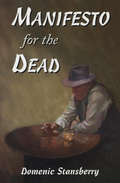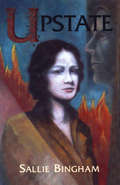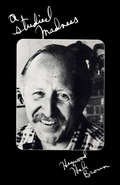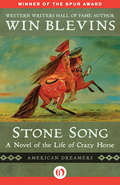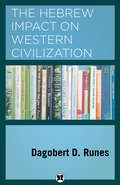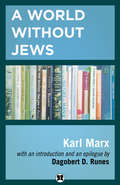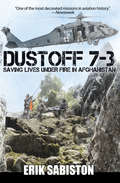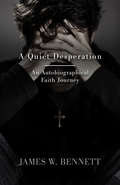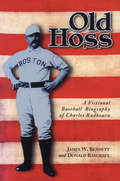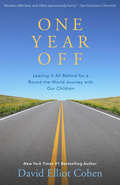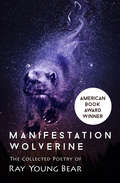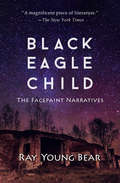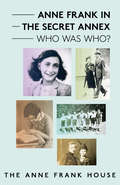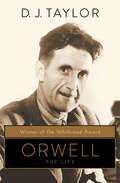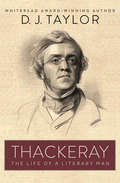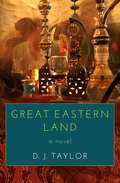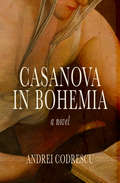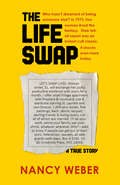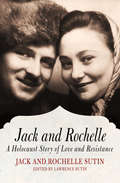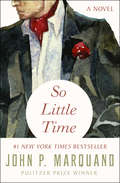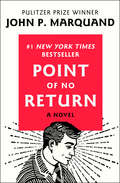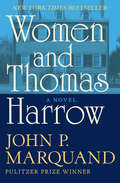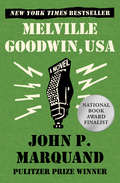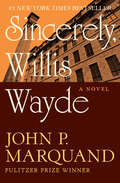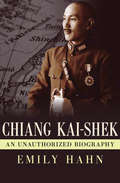- Table View
- List View
Manifesto for the Dead
by Domenic StansberryManifesto for the Dead is a surreal noir that takes as its main character the master of noir, the late crime novelist Jim Thompson at the end of his career, suspecting he has been framed by a Hollywood producer for the murder of a young starlet. An intricate blend of biography, fiction, and suspense, this literary thriller offers a hair-raising portrait of one of crime fiction's most notorious true-life figures--and a brutal satire of the entertainment industry in the tradition of The Day of the Locust. As the novel opens, the aging writer is at the end of his string--a habitué of Hollywood bars and endless drinking sessions at the Musso & Frank Grill. Here he is approached by a small-time producer, Billy Miracle, with an offer to work on a project designed to resurrect the career of a fading screen star. Thompson accepts, and soon finds himself at the center of a lurid triangle, inadvertently following a trail that leads from a dead starlet--found strangled in the back of a Cadillac--to the doorstep of one of the most powerful men in Hollywood. Set in the seamy back streets of Los Angeles, in 1972, Manifesto for the Dead tells the story of legendary crime writer Jim Thompson in his darkest hour. It is a book about desire and lust, about a writer struggling with illusion, disillusion and fate on the back lots of Hollywood. But the Manifesto is also a novel-within-a-novel, telling two stories that intertwine--one set in Hollywood, the other in Thompson's imagination--each rushing headlong into the other, into that area where fact and fiction are no longer distinguishable, and the darkness is inseparable from the light.
Upstate
by Sallie BinghamA woman's obsession drives an affair out of control, violating social contracts and devastating the people in its path. For years, Ann and David shared weekends and holidays with country friends Flora and Edwin, even after womanizing Edwin took Ann away to pick grapes and started a year-long affair. The ground rules were clear from the start: Flora accepted what she called Edwin's meaningless "things," and Edwin stipulated no divorces. But Ann's empty marriage (to which David was providing neither money nor sex) and growing need for Edwin causes her to ask for more, leading to estrangement and a startling climax.
A Studied Madness
by Heywood Hale BrounBrought back into print after 14 years and published in paperback for the first time, this leisurely meditation on the art of acting and on the author's life in that art demonstrates a good-natured sense of humor and an engaging style. In a series of essays, Broun gently knocks the theatrical world--the audience traveling from small town to small town only to have a production fold right outside of New York; the trauma of doing live TV; getting bit parts in commercials or horror movies after years of classical training; and so on. Oddly enough, while deglamorizing his profession, he makes a good case for it: he enjoyed his life.
Stone Song
by Win BlevinsWinner of the Spur Award and a nominee for the Pulitzer Prize: This classic tale of the West has been heralded by the Dallas Morning News as "a deeply spiritual story about the soul journey of a great and mysterious American hero" Of all the iconic figures of Native American history, Crazy Horse remains the most mysterious. Ridiculed as a boy for his unusual looks, he grew up to be a man who had no interest in the regalia that his fellow Lakota Sioux warriors coveted, and yet he led his people to their most famous victory: the defeat of General Custer at the Battle of the Little Bighorn. Called to a destiny of monumental significance and tortured by his deeply passionate love of a beautiful woman, Crazy Horse found peace only in battle. A visionary who drew inspiration from the eternal wisdom of his people, he discovered the means to defeat the US Army at its own deadly game. To this day, he strides across American history as a man who lived--and died--on his own terms.
The Hebrew Impact on Western Civilization
by Dagobert D. RunesAn eye-opening classic volume on the enduring cultural impact of the Jewish people This authoritative work considers the creative and cultural influence of the Jews throughout our time. At more than 800 pages, D. D. Runes has complied a mid-twentieth century account of the various contributions in many spheres in which the Jews have had an impact on western civilization. Eminent scholars consider the ways in which the Jews contributed toward the making of modern society and helped in raising human standards and values. Richard Van Dyck, in "The Jewish Influence on Journalism," observes that the preponderance of Jewish newspapermen disproves the commonly held belief that Jewish journalism is "necessarily subversive." William B. Ziff's "The Jew as Soldier, Strategist and Military Adviser" delineates the successes of Jewish military forces throughout history. Dr. Abraham I. Katsh discusses "The Hebraic Foundations of American Democracy," noting the influence of Hebrew Scriptures on standards of conduct in western civilization. Curtis Lubinski's "The Jew in Drama, Theatre, and Film" traces the success of Jewish performers and dramatists. The essays compiled in this volume are a fascinating and expansive look at the far-reaching impact Jews have had on Western life.
A World Without Jews
by Karl Marx Dagobert D. RunesLong available to the readers of Soviet Russia, here is the first English translation, in book form, of the unexpurgated papers of Karl Marx on the so-called "Jewish question." Most of Marx's anti-Semitic diatribes were carefully eliminated by the translators and editors of his books, his journalistic writings and his correspondence. Readers unfamiliar with this aspect of his thought will be startled to discover how well it has served the purposes of the totalitarian regimes of our time. It is consequently a subject upon which every member of a free society should be adequately informed. A fearless and illuminating critical introduction to this remarkable work has been provided by the eminent philosopher, Dagobert D. Runes. Extensive comments and critical annotations related to the material appear throughout the book.
Dustoff 7-3: Saving Lives Under Fire in Afghanistan
by Erik SabistonDustoff 7-3 tells the true story of four unlikely heroes in the rugged mountains of Afghanistan, where medics are forced to descend on wires to reach the wounded and helicopter pilots must fight wind, weather, and enemy fire to pluck casualties from some of the world's most difficult combat arenas. Complete opposites thrown together, cut off, and outnumbered, Chief Warrant Officer Erik Sabiston and his flight crew answered the call in a race against time, not to take lives--but to save them. The concept of evacuating wounded soldiers by helicopter developed in the Korean War and became a staple during the war in Vietnam where heroic, unarmed chopper crews flew vital missions known to the grateful grunts on the ground as Dustoffs. The crew of Dustoff 7-3 carried on that heroic tradition, flying over a region that had seen scores of American casualties, known among veterans as the Valley of Death. At the end of Operation Hammer Down, they had rescued 14 soldiers, made three critical supply runs, recovered two soldiers killed in action, and nearly died. It took all of three days.
A Quiet Desperation
by James W. BennettA Quiet Desperation is the straightforward autobiographical account of one man's disturbing journey through disabling mental illness and into the Community of Faith. This is a book that has provided help for many who have suffered psychiatric disorders, bringing hope without easy answers.
Old Hoss
by James W. Bennett Donald RaycraftCharles Radbourn won fifty-nine games in 1884, the stuff of legends. In eleven years he racked up over three hundred wins and forty-five hundred innings--mind-blowing numbers. And yet the facts of this Hall of Famer's play are more credible than the stories of his life of alcohol, womanizing, wild brawling, and, later, the ravages of syphilis. Radbourn's plaque at Cooperstown presents an image that is almost caricature: cap set forward, mouth open, mustache pricked up at the ends and thick as his nose is long, nearly. Not Charles, but Ol' Hoss. It is now May 1941, and the invented Chicago Tribune journalist John Trapp is on a train for Bloomington, Illinois, to cover ceremonies honoring the late Radbourn. Trapp meets (the real) baseballer Clark Griffith, who begins to tell him tales of the great pitcher. Our authors then have Trapp craft the first biography of the man, anchoring the details of his life in fact.
One Year Off
by David Elliot CohenHave you ever wanted to take a year off from your life? A meandering, serendipitous journey around the world with your family? It sounds impossible. But one day, David Elliot Cohen, co-creator of the bestselling Day in the Life and America 24/7 book series, decided to make this dream a reality. Over the course of six months, he and his wife sold their house, cars, and most of their possessions. He closed his business and pulled their three young children out of school. With only a suitcase, a backpack, and a passport per person, the Cohen family set off on a rollicking round-the-world journey filled with laugh-out-loud mishaps, heart-pounding adventures, and unforeseen epiphanies. In Botswana, the Cohens's tiny motorboat is charged by a hippo. In Zimbabwe, lions ambush a buffalo outside the family's tent. In Australia, their young daughter is caught in a riptide and nearly pulled out to sea. In One Year Off, you can join the family on a trek up a Costa Rican volcano, cruise the canals of Burgundy by houseboat, and ride ferries through the Greek Islands. Later, as the Cohens wander further off the tourist trail, you can drive through the villages of Rajasthan, traverse the vast Australian Nullarbor, and discover the charms of Cambodia's Angkor Wat and the hidden shangri-las of northern Laos. Over the course of these adventures, the Cohens learn to live as a family twenty-four hours a day, seven days a week and enjoy a once-in-a-lifetime opportunity to spend time together without the distractions of modern life. The author rediscovers the world through his children's eyes and gains new perspective of his own life. This humorous, heartfelt story is the next best thing to taking the trip yourself
Manifestation Wolverine: The Collected Poetry of Ray Young Bear
by Ray Young BearThe definitive collection from a groundbreaking Native American poet whose work traces the fault lines between past and present, real and surreal, comedy and tragedy to unveil a transcendent new vision of the world Hailed by the Bloomsbury Review as "the nation's foremost contemporary Native American poet" and by Sherman Alexie as "the best poet in Indian Country," Ray Young Bear draws on ancient Meskwaki tradition and modern popular culture to create poems that provoke, astound, and heal. This indispensable volume, which contains three previously published collections--Winter of the Salamander (1979), The Invisible Musician (1990), and The Rock Island Hiking Club (2001)--as well as Manifestation Wolverine, a brilliant series of new pieces inspired by animistic beliefs, a Lazy-Boy recliner, and the word songs Young Bear sang to his children, is a testament to the singularity of the poet's talent and the astonishing range of his voice.
Black Eagle Child: The Facepaint Narratives (Singular Lives Ser.)
by Ray Young BearMixing prose and poetry, ancient traditions and modern sensibilities, this brilliant, profane, and poignant coming-of-age story is a masterpiece of Native American literature At a Thanksgiving party held in a Bureau of Indian Affairs gymnasium, the elders of the Meskwaki Settlement in central Iowa sip coffee while the teenagers plot their escape. Edgar Bearchild and Ted Facepaint, too broke to join their friends for a night of drinking in a nearby farm town, decide to attend a ceremonial gathering of the Well-Off Man Church, a tribal sect with hallucinogenic practices. After partaking of the congregation's sacred star medicine, Edgar receives a prophetic vision and comes to a newfound understanding of his people's past and present that will ultimately reshape the course of his life. Set against the backdrop of the tumultuous 1960s, Black Eagle Child is the story of Edgar's passage from boyhood to manhood, from his youthful misadventures with Ted, to his year at prestigious liberal arts college in California, to his return to Iowa and success as a poet. Deftly crossing genre boundaries and weaving together a multitude of tones and images--from grief to humor, grape Jell-O to supernatural strobe lights--it is also an unforgettable portrait of what it means to be a Native American in the modern world.
Anne Frank in the Secret Annex: Who Was Who?
by The Anne Frank HouseAn extraordinary story of Anne Frank and the Secret Annex For two years during the Second World War, young, Jewish Anne Frank lived in hiding from the Nazis. Everything she experienced, thought, and felt, she confided in her diary. She was just as frank in her descriptions of the seven other people in the Annex and of the five helpers who endangered their own lives to look after them. Years later, Anne Frank's diary became world famous. The Secret Annex was so well set up that the hiders survived there for over two years. Who were these people, how did they meet, and what happened to them? This book shows the background and organization of the Annex and the personal stories of all involved, as well as their relationships and their fates. It also offers many never-before-published photographs. The result is an extraordinary group portrait that stays with the reader long after the last page is turned.
Orwell: The Life (Books About Bks.)
by D. J. TaylorWinner of the Whitbread Biography Award: the authoritative biography of one of the greatest authors of the twentieth century It was not easy to bury George Orwell. After a lifetime of iconoclasm, during which he professed no interest in religion and no affiliation with any church, he asked to be buried in an Anglican churchyard--but none would have him. Orwell's friends fought for him to have a proper grave, however, and the author of 1984, Animal Farm, and Homage to Catalonia, among other brilliant works of prose, poetry, and journalism, was laid to rest in a quiet country cemetery. Almost immediately, his legacy was in dispute. Orwell did not want any biographies written of him, but that has not stopped scholars from trying. Of all those published since the author's death in 1950, D. J. Taylor's prize-winning book is considered the most definitive. Born in India, Orwell spent his forty-six years of life traveling the British Empire and confronting the world head on. From the trenches of Spain to the top of bestseller lists, Taylor presents Orwell fully--as a writer, social critic, and human being.
Thackeray: The Life of a Literary Man
by D. J. TaylorA rich and evocative portrait of one of the greatest authors of Victorian England Who was William Makepeace Thackeray? Was he the wealthy dilettante who came to London in the 1830s and squandered his fortune on newspapers? Was he the impoverished freelance author of the 1840s who scrapped for every penny he could get? Or was he the great writer who published Vanity Fair in 1847, skewering Victorian society and ensuring his literary legacy? Throughout the many phases of his life, Thackeray remained an enigma. He was friendly but standoffish, generous yet miserly, confident and utterly terrified of failure. A century and a half after Thackeray's death, D. J. Taylor has produced a biography that tackles the complexities of these contradictions and restores Thackeray to his place in the literary pantheon. His fortune lost by the time he was thirty, his personal life in constant torment, Thackeray's story is as dramatic as that of any of his characters. In Thackeray, the man can finally be seen in full.
Great Eastern Land: A Novel
by D. J. TaylorPast and present collide for a man on a mission to document a history that may or may not exist, in this ingenious novel by the acclaimed author of Derby Day Dr. Feelgood's is a brothel overrun with fat, overindulged mice that lies at the western tip of a remote village somewhere in the Far East. It's presided over by Mr. Mouzookseem, an illiterate Englishman with his own reasons for fleeing the family fold for a life of anonymity. This is the beginning--or is it the end?--of a story that weaves in and out of time as David Castell immortalizes Mouzookseem and others in his notebook. A pragmatist whose father had his own ideas about what history can teach, David is a traveler of the mind and heart. Although he has been to exotic places, from Kashmir to the Russian steppe, he finds the domestic train from Paddington to Oxford hopelessly confounding--and the subject of an existential conversation. His musings unfold into a vivid tapestry of his own past, from his life as a student at Oxford to the women he loved and lusted after. As the stories and observations in David's notebooks take shape, they become an allegory for life, death, and the distortions of memory.
Casanova in Bohemia: A Novel
by Andrei CodrescuAn erotic, comedic, and compulsively readable historical novel depicting the beguiling Giacomo Casanova as he looks back on a life of love and ribald adventure In Count Waldstein's far-flung Bohemian castle, an aging Casanova spends his days as a librarian cataloging the count's extensive collection of books. Or at least that's what he's supposed to be doing. Ever the storyteller, Casanova instead dedicates himself to his own writing, for which the young servant Laura Brock serves as an endlessly fascinated audience. He recounts to her his greatest escapades--from romances in a Venetian convent to the seduction of an entire harem to the triumphant amassing (and subsequent loss) of a fortune in Paris. Enlivened by the French Revolution and the liberating ideas of the Enlightenment, Casanova's latest exploits prove he still possesses an intellectual vigor and insatiable curiosity. Even old age can't keep this legendary libertine--who corresponded with Voltaire, discussed flight with Benjamin Franklin, and whose life and writings inspired artists as diverse as Mozart, Flaubert, Stendhal, and Hesse--from causing trouble. Rich with eighteenth-century European social, political, and religious history, Casanova in Bohemia is an energetic and erotic portrait of Western literature's most beloved lothario, whose hedonism was matched by his creativity and wit.
The Life Swap
by Nancy WeberIn February of 1973, Nancy Weber put an ad in the Village Voice offering to trade places with another woman, a stranger, for a month. In hopes of better understanding what was fixed and final in each person--and what was invented, and therefore might be reinvented--they would use each other's names, live in each other's homes, love each other's loves, and do each other's work. After interviewing many of the fascinating women who answered the ad, Weber--single (with a longtime lover) and straight--chose a polyamorous, bisexual, married psychologist and academic, the pseudonymous Micki Wrangler. They spent five months getting ready for their adventure--cajoling their nearest and dearest into participating, exchanging thousands of details, and swapping deep secrets. But, instead of a month, their wild ride lasted only a week. Wrangler was having a rough time (and Weber too good a time, maybe) so they decided to call things off. Wanting The Life Swap to convey more than her own experience, Weber invited Wrangler and ten others to enrich the book with their uncensored reports. Publicity for the book included stints on The Tonight Show with Johnny Carson and To Tell the Truth. The book achieved a kind of cult status, in part because it's a relic of 1970s sexual openness (cruelly destroyed by HIV/AIDS) and belief in the right of self-invention. Recent critics have credited the book with inspiring life swap reality TV shows and several popular novels and films.
Jack and Rochelle: A Holocaust Story of Love and Resistance
by Jack Sutin Rochelle Sutin Lawrence SutinWhen the Holocaust descended on Poland, two young Jews fought back--and fell in love Jack and Rochelle first met at a youth dance in Poland before the war. They shared one dance, and Jack stepped on Rochelle's shoes. She was unimpressed. When the Nazis invaded eastern Poland in 1941, both Jack (in the town of Mir) and Rochelle (in the town of Stolpce) witnessed the horrors of ghettoization, forced labor, and mass killings that decimated their families. Jack and Rochelle managed, in their separate ways, to escape into the forest. They reunited, against all odds, in the winter of 1942-43 and became Jewish partisans who fought back against the Nazis. The couple's careful courtship soon blossomed into an enduring love that sustained them through the raging hatred of the Holocaust and the destruction of the lives they had known. Jack and Rochelle's story, told in their own voices through extensive interviews with their son, Lawrence, has been in print for twenty years and is celebrated as a classic of Holocaust memoir literature. This is the first electronic edition.
So Little Time: A Novel
by John P. MarquandA father frets over his son's future while reexamining his own past in John P. Marquand's enduring portrait of America on the brink of World War II A script doctor who divides his time between Manhattan, Hollywood, and a country home in New England, Jeffrey Wilson has entered middle age with all the trappings of success. Yet, in the months leading up to the attack on Pearl Harbor, he feels increasingly anxious and isolated. He fears that his eldest son, a college sophomore, will be called to fight before he has had a chance to live on his own terms. Two decades ago, Jeffrey served in World War I, and his life since then seems like a series of accidents. Instead of the journalism career he aspired to, he toils to fix other people's plays. By marrying into a prominent family, he gained wealth and stature, but sacrificed his autonomy. His friends and acquaintances, most of whom were chosen by his wife, are foolish and vain.. Powerless to rewind the clock or hold back the tides of global conflict, Jeffrey offers his son the one piece of advice that is impossible for a young man to hear: Time is running out. Witty, moving, and meticulously observed, So Little Time is the story of a crucial period in American history and one man's attempts to make sense of it all.
Point of No Return: A Novel
by John P. MarquandConsidered by many critics to be John P. Marquand's finest novel, Point of No Return is the story of a modern businessman borne back by fate into yesteryear Raised in the small town of Clyde, Massachusetts, Charles Gray has worked long and hard to become a vice president at the privately owned Stuyvesant Bank in Manhattan. But at the most crucial moment of his career, when his focus should be on reading his boss's intentions and competing with his chief rival for the promotion, Charles finds himself hopelessly distracted by the past. Years ago, the Gray family was featured in Yankee Persepolis, a sociological study of Clyde. Charles, his sister, and their parents were classified as members of the "lower-upper class," the unspoken strains of their tenuous social status cast in stark black and white. A chance encounter with the author of the study floods Charles's thoughts with memories, and when a business matter compels him to make a trip to Clyde, it seems as if the Fates are conspiring to turn back the clock. As he reflects on the defining moments of his youth, Charles contends with one of the central mysteries of existence: how our lives can feel both predetermined and random at the same time. Published in 1949, Point of No Return is a brilliant study of character and place heralded by the New York Times as "further proof that its author is one of the most important living American novelists."
Women and Thomas Harrow: A Novel
by John P. Marquand"Women and Thomas Harrow is Grade A Marquand, spellbindingly readable, smooth as cream in its polished technical craftsmanship, sardonically witty and filled with a special sort of wry and melancholy worldly wisdom." --The New York Times Playwright Thomas Harrow followed his first Broadway smash with Hollywood celebrity and became the toast of theaters from coast to coast. But the road to riches and fame has been anything but smooth. Now in his fifties, Thomas's three unhappy marriages have caused significant emotional and financial damage, and the disastrous failure of his musical Porthos of Paris will now force him to sell the beloved Federalist house he bought in his hometown of Clyde, Massachusetts. Tom's search for the causes of his current distress takes him back to his youth and through each decisive moment of his life: the literary successes, the hack work, the love affairs that turned sour. He married three charming, vivacious women--Rhoda, Laura, and Emily--yet never figured out how to share his thoughts and feelings with them. Partly the work was to blame, as the demands of his artistic life often ran counter to domestic arrangements. But with the wisdom of experience, Tom can also see that his character judgments were often mistaken, and that, despite his wit, charm, and intelligence, there is a fundamental part of himself that remains shrouded in mystery. Is there still time to unlock his heart, or has the window for love closed to him? An honest and moving portrait of a successful man's never-ending quest for happiness, Women and Thomas Harrow is one of John P. Marquand's most autobiographical novels.
Melville Goodwin, USA: A Novel
by John P. MarquandFinalist for the National Book Award: This sweeping novel set in the aftermath of World War II reveals the story behind the creation of an American icon Major General Melville A. Goodwin, the son of a druggist, served in two world wars, rising through the ranks to take command of an armored division. He was a hero long before he braved a hail of bullets to save a fellow American in postwar Berlin, but until that mad act of courage, no one outside of the military had ever heard of him. That is all about to change: A weekly news magazine has convinced the major general to sit down for an extended interview at the home of Sid Skelton, a popular radio commentator and former army buddy of Goodwin's. Over the course of many hours, Goodwin tells the story of his life--from his small-town childhood to his years at West Point, his battlefield traumas, his marriage to an ambitious woman who helped shape his military career, and his impressions of the world as seen through the barbed wire of far-flung army posts. Of primary interest to Skelton, however, is Dottie Peale, the vivacious journalist Goodwin romanced in war-torn France. Skelton is a little bit in love with her himself, and now that the major general is in the news, Dottie plans to make a dramatic return to his life. At the moment of his greatest triumph, Goodwin will discover that his marriage and career are under threat.
Sincerely, Willis Wayde: A Novel
by John P. MarquandThe unforgettable journey of an American businessman--from his humble origins to his extraordinary successes--and the compromises he made along the way When Willis Wayde first lays eyes on the Harcourt mansion near Clyde, Massachusetts, he is fifteen years old. His father is an engineer at Harcourt Mill, and Willis is awestruck by the family's wealth and power. Seeking guidance from Henry Harcourt, Willis meets Bess, the old man's granddaughter. Their friendship eventually blossoms into love as the elder Harcourt takes the young man under his wing, recognizing in Willis a kindred spirit whose instinct for making money matches his own. Pleased with his good fortune, Willis is nevertheless acutely aware of the great social gulf that separates the Waydes from the Harcourts. Determined to make his own way, he sets out on a path that will take him far beyond New England and the insular, old-money world of Henry and Bess. Then the Depression hits, wiping out the Harcourt family fortune. When he comes back into their life, Willis has the power to rescue the last vestige of the family's prestige: the mill. Torn between his nostalgia for a simpler, more sentimental time and his sharply honed business acumen, Willis must make a fateful decision.
Chiang Kai-Shek: An Unauthorized Biography
by Emily HahnAn in-depth biography of the towering 20th-century Chinese military and political figure who led the government, first on the mainland and then in exile in Taiwan, from the acclaimed New Yorker correspondent who lived in China when he was head of state In 1911, 24-year-old Chiang Kai-shek was an obscure Chinese student completing his military training in Japan, the only country in the Far East with a modern army. By 1928, the soldier who no one believed would ever amount to anything had achieved world fame as the leader who broke with Russia and released the newly formed Republic of China from Communist control. Emily Hahn's eye-opening book examines Chiang's friendship with revolutionary Sun Yat-sen and chronicles his marriage to the glamorous, American-educated Soong May-ling, who converted him to Christianity and helped him enact social reforms. As the leader of the Nationalist Party, Chiang led China for over two decades: from 1927 through the Japanese invasion, World War II, and the civil war that ended with a Communist victory in 1949. After defeat, he retreated with his government to Taiwan where he continued to lead as president of the exiled Republic of China until his death in 1975. Famous for forging a new nation out of the chaos of warlordism, he was an Allied leader during the Second World War, only to end up scorned as an unenlightened dictator at the end of his life. Casting a critical eye on Sino-American relations, Hahn sheds new light on this complex leader who was one of the most important global political figures of the last century.
